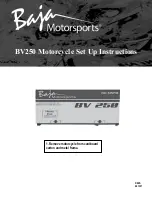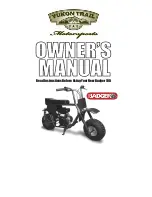
A
B
C
D
E
F
G
H
L
M
N
P
Uso e manutenzione
Use and Maintenance operations
sezione / section
D 4
41
edizione/edition 03-03
Rimuovere il coperchio del serbatoio
svitando le due viti a croce (5).
Rimuovere la membrana interna dal
serbatoio. Rabboccare con liquido
prescritto fino al livello massimo.
Rimontare i componenti rimossi.
Controllo usura per freno
posteriore
Controllare attraverso la fessura
ricavata tra le due semipinze che
risulti visibile almeno 1 mm di
materiale di attrito sulle pastiglie.
Importante
Se anche una sola delle
pastiglie risulta consumata sarà
necessario sostituirle entrambe.
Procedere alla sostituzione delle
pastiglie in questo modo:
Rimuovere la copiglia di sicurezza (1)
(sul lato interno della pinza) dal perno
tenuta pastiglie. Spingere i pistoncini
della pinza completamente dentro ai
propri alloggiamenti, divaricando le
pastiglie usurate. Sfilare il perno (2) di
tenuta pastiglie verso l’esterno.
Rimuovere la molla (3) di tenuta
pastiglie posta tra le semipinze.
Sfilare le pastiglie usurate.
Note
Sostituire le pastiglie che
presentano un aspetto lucido o
“vetroso”.
Inserire le pastiglie nuove e relativa
molla (3). Infilare il perno di centraggio
(2) e bloccarlo con la copiglia di
sicurezza (1) orientando il bordino (A)
verso la ruota. Azionare
ripetutamente il pedale del freno per
permettere l’assestamento delle
pastiglie sotto l’azione di spinta del
liquido freni.
Verificare che il livello nel serbatoio
risulti compreso tra le tacche di MIN e
di MAX. In caso contrario provvedere
al rabbocco dopo aver svitato il tappo
(4) del serbatoio.
Note
Se l’operazione di sostituzione
pastiglie dovesse risultare difficoltosa
rimuovere le pinze (Sez. G).
Attenzione
Essendo le pinze freno un
organo di sicurezza della moto,
attenersi a quanto riportato alla
Sezione G “Ruote - Sospensioni -
Freni” ed in particolare fare
attenzione, in fase di rimontaggio, alla
coppia di serraggio prescritta (Sez. C
3) delle viti di fissaggio delle pinze.
Unscrew the two cross-slot screws
(5) and remove the reservoir cover.
Remove the inner membrane from
the reservoir.
Top up to max level using the
specified brake fluid.
Reassemble.
Checking rear brake wear
Check through the slot between the
two caliper halves that there is at
least 1 mm of friction material on the
pads.
Caution
If one of the pads is worn,
change both pads.
To change the pads, proceed as
follows:
Remove the split pin (1) from the
caliper retaining pin. The split pin is on
caliper inner side. Force the brake
pads apart to force the caliper pistons
into their housings. Withdraw the
brake pad retaining pin (2) from the
outside.
Remove the brake pad retaining clip
(3) from between the two caliper
halves.
Remove the worn pads.
Note
Change pads which are shiny or
vitrified.
Insert the new pads and the clip (3).
Insert the retaining pin (2) and push it
fully home. Fit the split pin (1) with
the end (A) pointing to the wheel.
Operate the brake pedal repeatedly
so that the pads bed in under the
action of the brake fluid.
Check that the brake fluid level in the
master cylinder reservoir is between
the MIN and MAX marks. If this is not
the case, unscrew the reservoir cap
(4) and top up with brake fluid.
Note
In case of difficulties with pads
replacement, remove the calipers
(Sect. G).
Warning
The brake calipers are critical
safety components. Observe the
instructions given in Section G
"Wheels - Suspension - Brakes". Be
sure to tighten the brake caliper
mounting bolts to the specified
torque on refitting (Sect. C 3).
MAX
MIN
5
1 mm
1
2
A
1
2
2
3
MAX
MIN
4
'8&PRB66B'EERRN3DJH7KXUVGD\0DUFK30
Summary of Contents for SS1000DS
Page 10: ......
Page 11: ...A B C D E F G H L M N P Generalità 0 Description 0 ...
Page 24: ......
Page 25: ...A B C D E F G H L M N P Informazioni sul modello 0 Model specific information 0 ...
Page 29: ...A B C D E F G H L M N P Caratteristiche tecniche 0 Technical specification 0 ...
Page 67: ...A B C D E F G H L M N P Uso e manutenzione 0 Use and Maintenance operations 0 ...
Page 114: ......
Page 115: ...A B C D E F G H L M N P Vestizione 0 Fairing 0 ...
Page 133: ...N L H G F E D C B A P Comandi Dispositivi 0 Controls Devices 0 ...
Page 160: ......
Page 161: ...N L H G F E D C B A P Ruote Sospensioni Freni0 Wheels Suspensions Brakes 0 ...
Page 204: ......
Page 205: ...A B C D E F G H L M N P Mototelaio 0 Frame 0 ...
Page 233: ...A B C D E F G H L M N P Impianto di alimentazione Scarico 0 Fuel system Exhaust system 0 ...
Page 272: ......
Page 273: ...A B C D E F G H L M N P Impianto iniezione accensione 0 Ignition injection system 1 ...
Page 292: ......
Page 293: ...A B C D E F G H L M N P Motore 0 Engine 1 ...
Page 448: ......
Page 449: ...A B C D E F G H L M N P Impianto elettrico 0 Electric system 0 ...
Page 518: ......
Page 519: ...A B C D E F G H L M N P Indice degli argomenti 0 Subject index 0 ...
Page 528: ......
















































